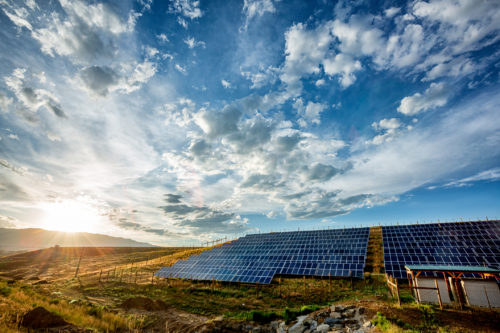
Community-Scale Solar Is on the Fast Track to Grid Parity
Will 2018 be the year when solar power reaches so-called grid parity, providing a cost of energy over its operating life that is equal to or less than the cost of energy from existing conventional energy sources?
This levelized cost of energy (LCOE) comparison informs new grid investments and, as a result, the evolving resource mix of the grid. Solar energy reaching true grid parity would fundamentally accelerate the global adoption of renewables and enable value creation even if existing conventional assets with high operating costs, like inefficient thermal plants, end up being stranded.
Looking across the energy landscape, there is reason to believe solar’s time truly has arrived. A review of estimated operating costs of power generation across sources leads to the conclusion that solar power in fact is close to—or is already at—this inflection point. At the global level, solar and wind installations now have the lowest life-cycle cost of all generation sources, according to data from the the World Economic Forum (WEF) released in December 2016. Also late last year, a new record was set in Saudi Arabia for the lowest-cost solar on the planet—under 2 cents per kilowatt-hour.
The investment bank Lazard, with its Levelized Cost of Energy 2017 analysis fresh off the presses, confirmed the outlines of WEF’s analysis with its own data on U.S. solar prices. Lazard’s new research showed that both utility-scale solar photovoltaic (PV) and wind are less expensive than new conventional thermal generation sources like coal, natural gas, and nuclear when a facility’s costs are spread over the operating life of the installation.

However, with the current installed base of 100 gigawatts (GW) of nuclear plants, 267 GW of coal, and 447 GW of natural gas facilities in the U.S., the real challenge for new solar and wind generation is to have a less-expensive levelized cost than the cash cost of existing assets. When this inflection point is met, even owners of existing assets will benefit financially from building new solar, independent of whether they still have debt to service on their existing assets or not.
Utility-scale solar is already at this important inflection point of true grid parity. Lazard boldly claims that utility-scale solar PV at $45/MWh in several cases has lower life-cycle costs than the operating cost of conventional thermal-generation sources.
This comes at a time when new data supplied by Xcel Energy from its 2017 project solicitations revealed median bids of $29.50/MWh for utility-scale solar in Colorado. And cost trajectories for solar indicates that these price levels can be maintained or improved even with the headwinds of the Investment Tax Credit phase-out, potential tariffs on foreign-made solar panels, and the implications of the newly passed U.S. tax reform package.
However, community-scale solar (CSS)—mid-scale PV systems deployed on the distribution grid—is trending to catch up with and even overtake utility-scale installations and provide an even lower-cost source of power. In contrast with Lazard’s range of $75 to $150 per MWh, a recent development of distribution-scale solar in New Mexico demonstrates that prices below $45/MWh for a fixed-term power purchase agreement (PPA) are achievable for installations of between 1 MW and 3 MW.
Rocky Mountain Institute believes community-scale solar installations deployed on the distribution grid, by serving all types of off-takers at low cost, combine attractive economics with attributes that utility-scale and rooftop solar installations can’t capture. For example, community-scale systems are large enough to access low costs through economies of scale and small enough to efficiently interconnect into distribution systems. While rates vary across markets, the typical cost for moving power over the transmission grid from a utility-scale asset to the consumer is around $10/MWh, a cost that these small-scale installations can avoid.
While still a nascent market, CSS is attracting a lot of attention from developers with its promise of becoming the new growth engine for the solar industry. RMI is working directly with distribution cooperatives, municipal utilities, and universities in Colorado, New Mexico, and Texas, as well as communities in New York State, to develop local community-scale solar installations. RMI expects these developments will deliver clean, renewable solar power that is cost competitive with conventional conventional large-scale power sources.
RMI’s Shine team just issued a new RFP for as much as 13.25 MW of solar PV generation and storage in Texas. In another recent request for proposals to build multiple 1–3 MW projects in Colorado, 59 developers indicated interest in participating, of which 29 actually bid into the opportunity.
With these dynamics in mind, when distributed solar reaches true grid parity more broadly across markets, the techno-economic potential for widespread adoption is close to unlimited. That’s an inflection point we should all monitor and celebrate in this new year.
Image courtesy of iStock.
